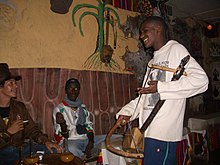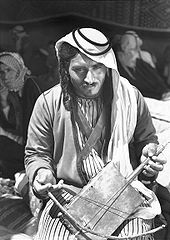Masinko

The Masinko , also masenqo, messenqo, massaneqo , is a single-stringed box skewer lute in Ethiopia . The country's only traditional string instrument is mostly played by professional ballad singers (azmaris) for entertainment.
Origin and Distribution
The spit-sounds widespread in North Africa are divided into three groups, the design of which indicates a different origin. The long straight neck made of a wooden stick goes through the body and protrudes a short distance on the opposite side. In West Africa, inland skewers with bowl-shaped resonance bodies are common. These include the plucked ngoni in Mali and their relatives in the Sahara : the tidinit in Mauritania and the tahardent , their counterpart among the Tuareg , as well as the single-stringed fiddle imzad of the Tuareg and the goge , the same instrument played by the Hausa . They came from Egypt to the Maghreb early on , where they were picked up by the Arab conquerors and, with the Islamization of the 11th century, brought south to the western Sudan region . In East Africa, some tube skewer violins of the Ugandan endingidi type have been widespread since the end of the 19th century , and their origin is believed to be in China .
The third, rarer group are the box skewers, the rectangular body of which consists of four boards joined to form a frame. The best known is the three-string Moroccan plucked gimbri . Of the formerly north of the Sahara spread one-string violin spit is practically only the rarely performed ribab the Moroccan Schlöh - Berber left with a small box-shaped sound box. The origin of the single-stringed box-shaped spike violins is seen in the " poet's fiddle" rabābah played by the Arab Bedouins . As the nickname suggests, this instrument, covered on both sides with animal skin, is part of old regional storytelling traditions and was previously played mainly by the Sulubba (Sulaib, Sleb), a despised tribe of blacksmiths, tinkers and donkey breeders. In variations of the word rabāb , numerous other string instruments from Morocco to Southeast Asia ( rebab ) are known. The distribution area of the masinko roughly corresponds to that of the Ethiopian blown flute waschint with four finger holes. The fact that the Tuaregs in West Africa use an almost identical flute confirms the connection between the masinko and the local fiddle imzad . A masinko is depicted in an Ethiopian manuscript from the early 18th century. The Scottish traveler James Bruce saw in Ethiopia in 1774 that Muslims were playing masinko and attested that it was of Arab origin.
Design

The Bedouin rabābah has a square body through which the wooden truss rod penetrates at right angles in the middle of the side. With the masinko , the neck runs diagonally through holes in opposite corners of the square or diamond-shaped body. While in the Moroccan ribab the vortex is obliquely inserted through the neck end, so that the string asymmetrically on one side of the web results in projecting the long vertebrae in rababa and masenqo at right angles to the front. The only horsehair string runs more than ten centimeters from the neck from the vertebra to the bridge. Directly behind it, according to the West African ngoni- type bowl sounds , it is knotted to a cord or leather loop, which in turn is attached to the neck spike, which protrudes slightly from the lower part of the body. Instead of the top and bottom made of solid material, the body frame is covered on both sides with untanned cow or goat skin. A seam around the side connects the pieces of skin. A V-shaped woody branch serves as the bridge, which can be set up in two positions with different sound results: If the bridge rests with one of the two legs on the outer wooden frame, the vibrations from the string are only transmitted via the other leg to the skin membrane, which makes a clean tone. On the other hand, a bridge that is placed in the middle of the membrane and slightly inclined produces a less clear tone.
In addition to self-made timber, boards from overseas packaging boxes or disposable pallets are also suitable for the body frame. Woodworking is done roughly with an ax, then with broken glass as a scraper, and finally with sandpaper for smoothing. To clean the fresh animal skin, it is first placed in boiling water, then rolled up, wrapped in a cloth and wrapped in airtight material. After four to seven days, the fur is softened enough that it can be scraped off in warm water. The moist skin tauts itself when it dries and thus achieves the necessary firmness. The 35 to 40 centimeter long bow ( degan ) consists of a piece of branch that is heated over the fire and stretched at the ends with a string to form the desired semicircle. After a week of drying, the shape is sufficiently stabilized, the branch is shortened to the required length and covered with a tuft of about 130 horse hair. To increase the friction, the player rubs the bow hairs with incense resin .
There are regionally different body sizes. With the Tigray in the north it is about twice as big as with the Oromos in the south, while the Amharen build a medium-sized instrument. The Oromo use both the masenqo , including for the shell lyre krar the term timbo .
Style of play
The player holds the masinko upright between his knees while sitting, his neck leaning against his left shoulder. Azmaris who play while standing carry the instrument on a strap hanging diagonally over their shoulder. In both positions, the lower end of the vertebra protrudes into the left armpit. With the palm of your left hand on your neck, touch the string slightly from the side with your fingers extended. There is no fingerboard to depress the string. The masinko , which is played with quick bow movements, has a warm, full sound and can be played with astonishing virtuosity. In instrumental pieces, the basic melody is richly ornamented; as an accompanying instrument, the masinko roughly follows the vocal part.
Azmaris used to be at the service of the nobles. Today they perform price and vicious songs either as a solo entertainer or with a singer in Tej bets , simple pubs where Tej honey wine is served. In the duo, the woman starts singing, followed by the man until they both sing together. The singer shakes her shoulders in Eskista , the traditional dance of the Amhars. Women alone do not make music. The wandering ballad singers have a repertoire with mythologically exaggerated stories from the past, old battle songs and everyday stories. For their clients at weddings and other family celebrations, they compose price songs and comment on daily events; the Azmaris' improvised ridicule can be directed against politics in general or against those present in the room, especially if they fail to slip a small bill in time. During religious celebrations, Azmaris mingle with the crowd to earn some change with Christian hymns and masinko games. Despite their important cultural function, Azmaris traditionally have a low social status. One of the most famous Azmaris playing masinko is Chalachew Ashenafi.
In the highlands of Ethiopia there are four pentatonic tone scales ( Modi , in Ethiopia kiñit ), which also stand for a certain genre of song. One of them, anchihoy, is reserved for the music of the Ethiopian Orthodox Church , which is not played on the masinko. The most popular among the Azmaris is the scale tizita , which stands for “nostalgia”, “feeling”, “memory” and “longing”. Azmaris popularized tizita by singing accompanied by masinko or krar . The melodies sounding wistful form the basis for the Ethiopian jazz music developed in the 1960s. The classic scale ambassel and the related scale batti can also be played on the masinko . One of the two variants of the ambassel corresponds to the Mixolydian mode . In addition, the Doric and Phrygian modes are common. The stringed instruments are tuned according to the respective scale (kiñit) .
In addition to the Azmaris bard music, there are orchestras in which the masinko plays together with other traditional melody instruments and drums in secular light music . A typical line-up consists of two masinkos , one krar and one to three bamboo flutes ( waschint ) . The double-skinned, hand-struck drums kebero and atamo generally only play a subordinate role.
Discography
- Orchestra Ethiopia. Ethiopiques 23rd Buda Musique, Paris
- Traditional music from Ethiopia. Alemayehu Fantaye ( masinko, krar, beganna , vocals), Yohannes Afework ( washint ). Acustic Music Records, Osnabrück 1994
literature
- Ronald Lah, Timkehet Teffera: Masenqo. In: Laurence Libin (Ed.): The Grove Dictionary of Musical Instruments. Vol. 3, Oxford University Press, Oxford / New York 2014, p. 410
- Ulrich Wegner: African string instruments. (New episode 41. Department of Music Ethnology V.) Museum für Völkerkunde Berlin 1984, pp. 128–131
Web links
- Musical instrument: Masenqo. Museum of Natural and Cultural History (illustration)
Individual evidence
- ↑ Wegner, p. 131
- ^ Anthony Baines: The Oxford Companion to Musical Instruments. Oxford University Press, Oxford 1992, p. 277
- ^ Roger Blench: The Morphology and Distribution of Sub-Saharan Musical Instruments of North-African, Middle Eastern, and Asian, Origin. (PDF; 463 kB) In: Laurence Picken (Ed.): Musica Asiatica. Vol. 4 Cambridge University Press, Cambridge 1984, p. 171, ISBN 978-0521278379
- ↑ Ronald Lah, Timkehet Teffera, 2014, p. 410
- ↑ Timothy Johnson: Music Theory Ethiopian Music. FSU, World Music Online
